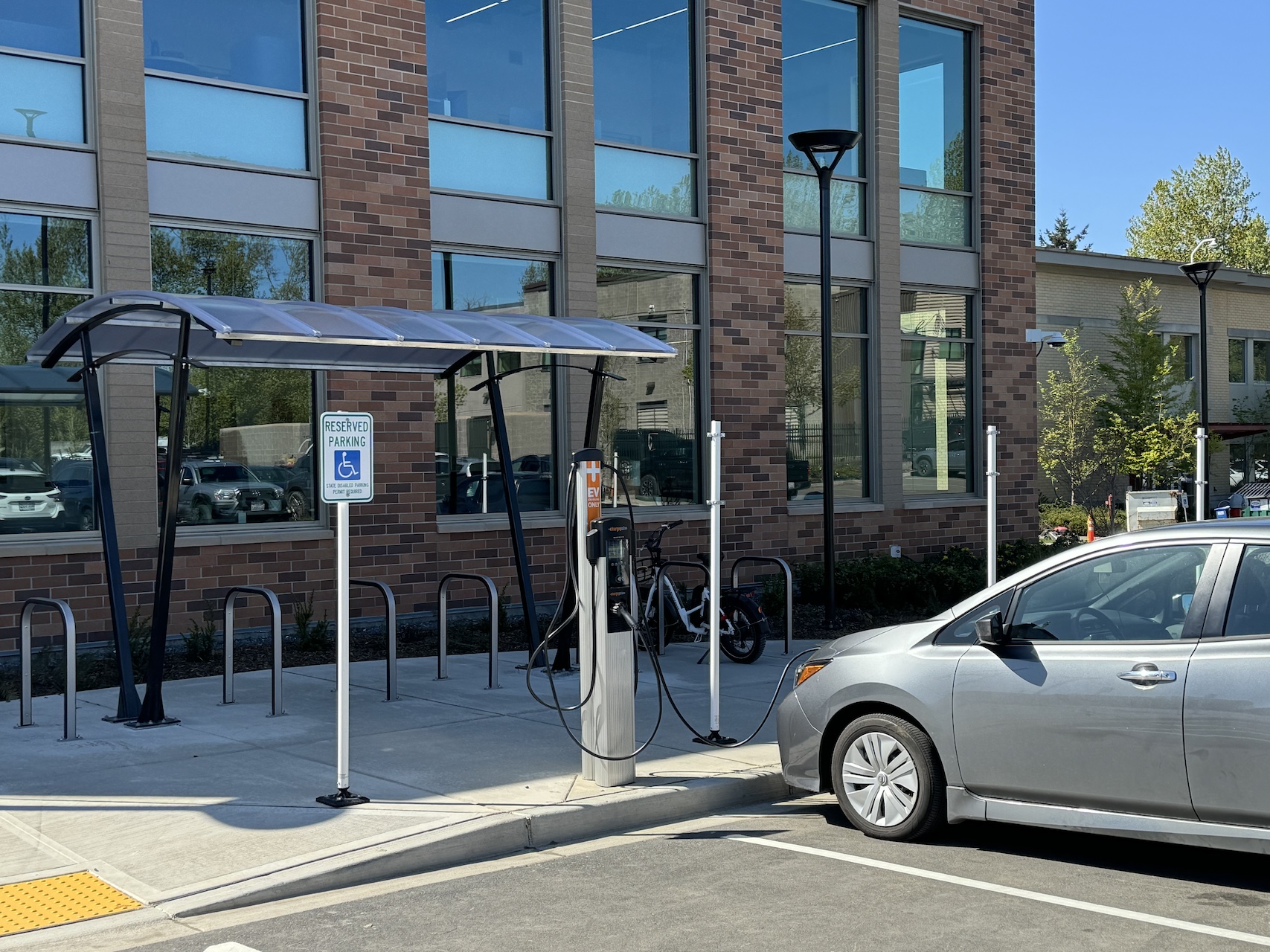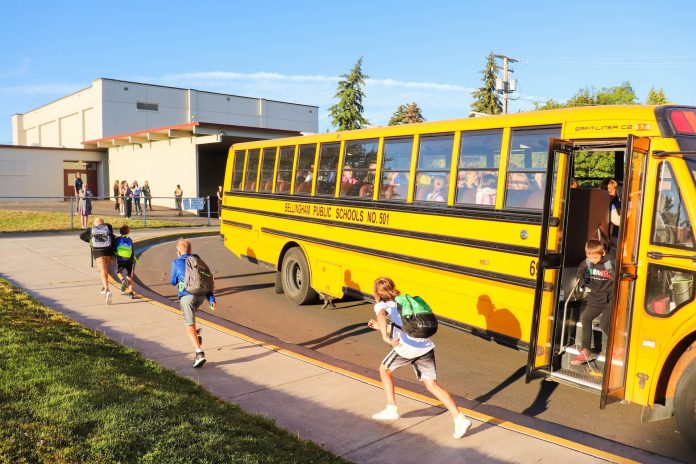School Transportation News is highlighting U.S. Department of Education Green Ribbon Schools winners in celebration of Earth Day. Bellingham Public Schools in Washington won the award in 2022 and continues to focus on increasing student ridership, adopting clean school buses and bike education.
Gretchen Pflueger, the grant writer and special projects manager for the district involved in the application process for the Green Ribbon Schools recognition, said when applying for the award district officials started conversations at the state level about initiatives that were taking place.
She noted that one of the things that stood out was a 2016 transportation levy passed by voters. It consisted of updates for the aging bus fleet, purchasing buses to implement a new high school schedule, and providing more access to field trips, as well as installing bus technology for improved student safety.
“That really set us on a path for transportation to be clean and efficient as possible,” Pflueger said. “We have a really supportive community in the sense that we are typically able to pass our bonds and levies and so that really helped us be on the forefront of transportation because we had a lot of clean buses really early on.”
Related: National Green Ribbon Schools Focus on Sustainability, Environmental Impacts
Related: Green Ribbon Schools Profile: Albemarle County Public Schools
Cindy Dennis, director of transportation, confirmed that all 77 school buses in the fleet are diesel-powered, but the entire buses running regular routes (62) are newer than 2014. She noted that Bellingham has a robust maintenance schedule to ensure all buses are always running at optimal levels.
Increasing Bus Ridership
Jessica Sankey, chief operating officer for the district, said a climate action plan developed over the past several years identifies targets and specific goals. She said school transportation is viewed through a sustainability lens, which may be different for some districts.
She added that Bellingham is a strong community and supports activities such as biking and walking to school with a goal of active transportation. In fact, a majority of the people interviewed by School Transportation News for this article biked to work that day. Many bus drivers also bike to the facility to pick up their bus and route for the day.
“Oftentimes, though, our active transportation advocates are ahead of those of us who build infrastructure,” Sankey said. “So, we’re often trying to race to keep up with the desires of the community, which are often the right thing.”
She added that after starting her current job in 2020, she realized quickly that a little over 10 percent of the community population are students in the district. This, she added, means a lot of people need to get to the same place at the same time and thus their bell schedules drive traffic. This is why increasing bus ridership is so important.
“It’s safe for kids,” she said. “It’s convenient for parents, but tremendously important because it takes individual cars off the road. It’s very, very impactful.”
Sankey said Dennis has focused on that while also trying to make the bus more convenient for people to use.
Dennis agreed, adding that increasing bus ridership has been her focus since she joined the district almost two years ago. “To really look at ridership and determine why people aren’t riding at the ground level, really looking at our routes, making sure that we are not only are serving the students that are outside of the mile, but creating stops that are made on that mile border so we can bring in a lot of students that might not be able to ride with us otherwise and make that convenient for them,” she noted.
Dennis said transportation performs outreach in areas that don’t have a high percentage of ridership to remind them residents that a bus comes into their neighborhood. She said an upcoming summer project is to review ridership and reach out to families to ask why they’re not riding the school bus.
“Is there something that we need to work on or improve on that?” she asked.
Another piece of the puzzle, Dennis said, is operating a transportation department that understands that the students are customers and transportation needs to work to meet their needs.
“I think the old way of thinking about transportation was that it was privilege,” she said, adding that the perception should change. “How do we keep kids on the bus? How do we get more kids on the bus? Make it comfortable? By doing that and offering a friendly, warm environment to families, it really increases ridership which overall is a benefit for everybody.”
Related: Washington Law Provides Contracted Bus Drivers Same Benefits as District Employees
Related: Updated: Washington Bill to Outlaw School Bus Trespassing Becomes Law
Related: EPA Announces Latest Grant Program Prioritizing Electric School Buses
However, she said that she realizes that the bus isn’t for everybody. But her job as the director of transportation, she shared, is to ensure every student gets to school safely. This includes working with the city public works and community partners to ensure students are educated on getting to school safely, whether that be bike education or walking paths.
Pflueger said her family is one that benefited from an additional stop in their neighborhood, where they live at the border of the one-mile radius from school. “I have praised Cindy for all of her great work because she added a stop at the end of our street that we previously had to either walk or drive to school and it’s always a giant hill,” she said. “Now we have almost 15 kids taking the bus to and from school [in that one neighborhood].”
Other Fuel Options
Dennis added because the bus fleet is so new, Bellingham doesn’t qualify for many available state or federal grants. Plus, electric school buses are not a focus of the district at this time because of the local geography and length of existing routes. Instead, she said, the district is looking at adopting propane, with new purchases expected in the fall.
But Bellingham has added battery-electric district support vehicles. Four EV chargers are located at one high school and six are at the district office. The district secured a grant for two more EV chargers that will be placed at an elementary school. Transportation is responsible for maintenance on all transportation-related vehicles as well as for purchasing all vehicles.

Bike Education
The district’s bike education curriculum is another piece of the active transportation initiative. As part of the Move Ahead Washington transportation bill passed in March 2022, a school-based bicycle safety education program is rolling out to grades three through eight across the state. Bellingham is one of the pilot districts taking this program on for pre-kindergarten through fifth grade. It consists of anywhere from five to eight lessons, depending on the grade level. Students learn about bike safety, especially when going to school.
The Let’s Go Program through Cascade Bicycle Club provides elementary schools with the resources to implement an in-class bicycle and pedestrian safety program for students. Dana Smith, assistant director of communications and community relations for Bellingham, said it’s difficult to ride a bike if students don’t have access to one or a safe place to learn. The district is working with Let’s Go and the state of Washington to develop a curriculum. Currently, five of the district’s 14 elementary schools are teaching the curriculum.














